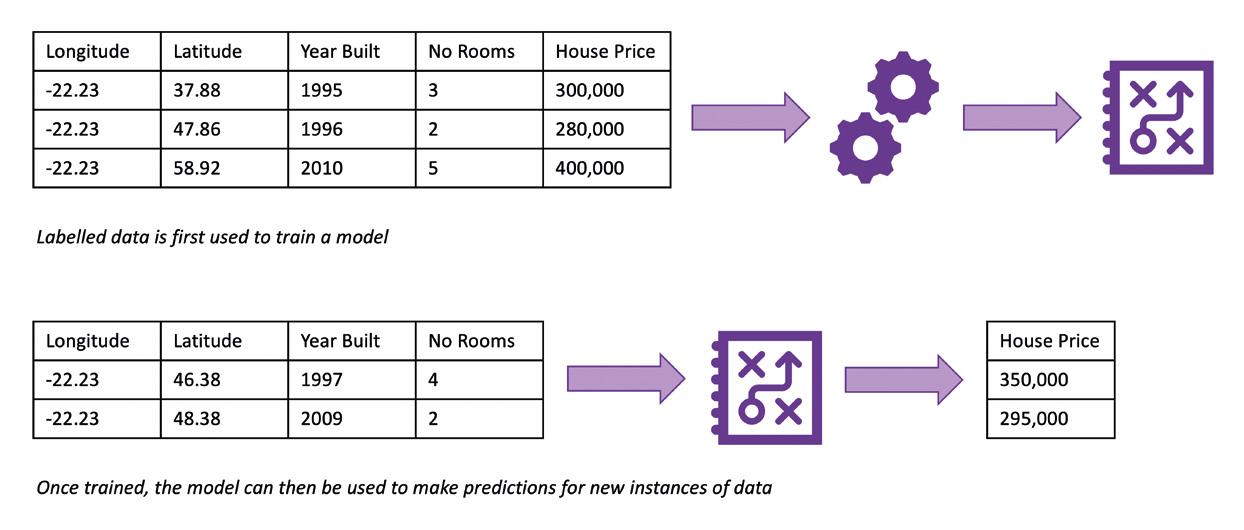
3 minute read
WELCOME TO THE MACHINE
WHAT CAN MACHINE-LEARNING DO FOR YOUR BUSINESS?
The revolution in artificial intelligence (AI) and machine learning (ML) over the last decade has seen headlines such as DeepMind’s AlphaGo beating a world-master Go player and the arrival of self-driving vehicles. There have also been impressive impacts on everyday life, such as improved shopping recommendations or targeted advertising. Some have expressed fears of advanced AIs taking over our jobs. But while the impact on our lives will be dramatic, in the shortterm technology will augment workers rather than replace them. Demystifying the ideas behind AI/ML shows how embracing it can positively impact and enable your business.
ML is a branch of AI, working with small or large datasets to train a model to make a prediction about something (a house price, based on size and location) or classify something (is an email spam or not). Data preparation is the first step to train a model. This involves removal of errors, enriching the data with other sources, and identifying features for training. Features might be numerical (e.g. raw sensor values) or categorical values (e.g. weekday or weather). In spreadsheet terms, features are columns, and training data are rows.
Once you have the training data, the model is trained by supervised or unsupervised learning. In supervised learning, each instance of data is labelled with the actual prediction or classification, often manually. Labelled data is fed into the model, and the prediction accuracy is assessed. Training takes several iterations with the model evaluated against a validation dataset to enhance the performance. A trained model is used to predict or classify new, never-before-seen un-labelled data.
In unsupervised learning, training data is not labelled and is fed into the model using just the features. Clustering algorithms are a popular type of unsupervised learning – they group unlabelled data into clusters with similar features. Unsupervised learning algorithms can power systems that classify and group documents or financial systems that predict fraud, as fraudulent transactions are often outliers to clusters of nonfraudulent transactions.
Now we know some basics about ML, what about tangible business value?
Predicting Sales Cycles:
Sales cycles that revolve around anything more complicated than seasons or the weather can be hard to predict. ML enables more accurate predictions of complex cycles by utilising public or proprietary data. A retail business such as a bakery can use this data to match production with expected demand, cutting wastage and reducing cost.
Predicting Equipment Failures:
Many companies have IoT sensor data. Rail maintenance companies, for example, can use their infrastructure sensor data to predict failures, improving reliability and reducing maintenance cost.
Visually Identifying Materials and Defects:
Computer vision advances mean that models can be trained for previously impossible tasks for computers. e.g. spotting defects in the manufacturing process or identifying materials within the built environment.
Document Classification and Summarisation:
Many organisations have numerous documents, but it can be challenging to find information. Search engines help, but by using supervised and unsupervised learning classification models, documents can be grouped together for more effective organisation. Additionally, ML can be used to summarise documents, reducing the time and cost of managing and finding information.
Fraud Prevention:
Unsupervised learning can spot fraudulent transactions, often classified as outliers compared to legitimate transactions. A similar approach applied in manufacturing can identify product defects or find items that do not conform to a required quality or standard.

The field of AI/ML is exciting, with significant potential. One day we may converse with intelligent automatons driving us around and doing our jobs, but we are not (entirely) there yet. I hope this article demonstrates the potential for ML to make a positive impact on your business today, even if your business is not Google as these algorithms are often free and open source. The hard part is putting an ML hat on, getting the data together in the right place, in the correct format, and asking the right questions.











